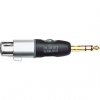guitarman19853
Member
Just curious how you guys handle gigs that expect you to use their backline for the gig.
The requirement for this gig is that you use their cabs at least so that they don't have to re-mic. You can use your own head but must use their cabs.
Should I show up with the AxeFx and just tell them I am direct and need a line (or 2 if they'll let me run stereo) or should I bring a backup pedalboard with me to use with their backline? Or should I try and clear it with them ahead of time?
If I have to use their backline, I think I'd rather use my "rehearsal" pedalboard than try to make patches without amp modeling and hope they work with whatever amps are there...
We're a new band and feel honored to get into this festival so I don't want to make a fuss about anything that would piss someone off.
And it's not until July so I have some time...
The requirement for this gig is that you use their cabs at least so that they don't have to re-mic. You can use your own head but must use their cabs.
Should I show up with the AxeFx and just tell them I am direct and need a line (or 2 if they'll let me run stereo) or should I bring a backup pedalboard with me to use with their backline? Or should I try and clear it with them ahead of time?
If I have to use their backline, I think I'd rather use my "rehearsal" pedalboard than try to make patches without amp modeling and hope they work with whatever amps are there...
We're a new band and feel honored to get into this festival so I don't want to make a fuss about anything that would piss someone off.
And it's not until July so I have some time...

